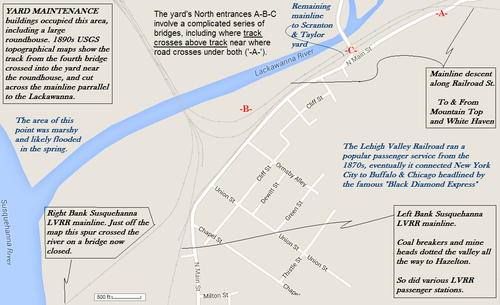This is an old revision of this page, as edited by Fabartus (talk | contribs) at 03:32, 9 April 2017 (→References: +cats). The present address (URL) is a permanent link to this revision, which may differ significantly from the current revision.
Revision as of 03:32, 9 April 2017 by Fabartus (talk | contribs) (→References: +cats)(diff) ← Previous revision | Latest revision (diff) | Newer revision → (diff)
Duryea Yard (formerly Coxton Yard, sometimes Pittston Junction, West Pittston Yard, or West Pittston Yard) is a railroad yard in the Wilkes-Barre/Scranton metropolitan area currently operated by the Reading Blue Mountain and Northern Railroad. Originally constructed in 1870 by the Lehigh Valley Railroad as a turn-around and staging hub for coal transport from the "Coal Region" to Eastern big-city markets, the yard remains a hub for the energy extraction industry today (as of 2017).
History
Further information: Lehigh Valley Railroad § HistoryFounding
The Lehigh Valley Railroad (LVRR) was founded in the 1830s, in a successful attempt to break the Lehigh Coal & Navigation Company monopoly over bulk goods shipping on the Wyoming-Lehigh-Delaware route. Even before reaching Wilkes-Barre, the LVRR had become the trunk line for the Lehigh Valley; shortly after purchasing the Penn Haven and White Haven Railroad, the LVRR completed its line to Wilkes-Barre in 1868.
At that time, all industrial activity was powered in some form by coal, and the Wilkes-Barre/Scranton area was a center of the coal mining industry. The LVRR and its competitors expanded rapidly, and the LVRR needed a yard to handle the traffic. That yard was Duryea yard.
20th Century
Duryea yard remained busy during the second half of the 19th century and the first half of the 20th. Following World War II, large dump trucks began to supplant rail for bulk coal hauling. Furthermore, rail companies began to dieselize to cut costs and remain competitive as the Interstate Highway System provided a novel form of highly-subsidized competition. Even though the shift to interstate highways was somewhat delayed in the mountainous Eastern Pennsylvania terrain, the shift to diesel was already eliminating much of the LVRR's revenues. Ironically, the railroad's steadiest profits came from carrying the cement and steel products necessary to build the interstate highways. The Duryea railyard declined as I-81 finally came to Scranton and airline travel began to compete with railroads on the few products that needed to be shipped faster than by truck. By the start of the 21st century, Duryea yard was mostly unused.
21st Century
In late 2009 and early 2010, The Reading Blue Mountain and Northern Railroad expanded operations due to the emergence of Marcellus Shale natural gas drilling in northeastern Pennsylvania. The Reading & Northern Railroad spent $100,000 to transform the Pittston Yard to a sand transloading facility to transfer sand from rail cars to trucks, which is then used by natural gas well drillers in the Marcellus Shale region. The upgrades to the railyard included laying new track to accommodate 100 new rail cars and constructing a facility to store and hold up to 800 cars of sand to be used in fracking at Marcellus Shale drill sites throughout Northeastern Pennsylvania.
Geography
The yard lies in the borough of Duryea, a secondary community of Pittston, itself a secondary community of Wilkes-Barre and Scranton. Physically, the yard is located on the main branch of the Susquehanna River and in the peninsula formed by the confluence of the Lackawanna.

The main Wyoming Valley entrance is through a railyard wye to the mainline, running westbound on both sides of the Susquehanna and eastbound to Mountain Top. Historically, the wye was doubled and connected to a long staging (transfer) track, but only parts of the doubling remain (see map at right). Continuing into the yard from the wye is to cross a bridge built for four tracks, although now only supporting three. This lead historically contained several crossovers fanning out to various service tracks and buildings within the yard.
On the north side, the yard connects to the LVRR's northbound main to Sayre, Pennsylvania.
Notes
- Although the 2017 RBM&N System Map names Duryea yard as such, a past version of this article claimed (via original research) that RBM&N had renamed Duryea Yard as "Muller yard." See photo at right.
References
- "Old Duryea railroad yard taking on new life"
41°20′35″N 75°47′11″W / 41.34300°N 75.786433°W / 41.34300; -75.786433
Categories: